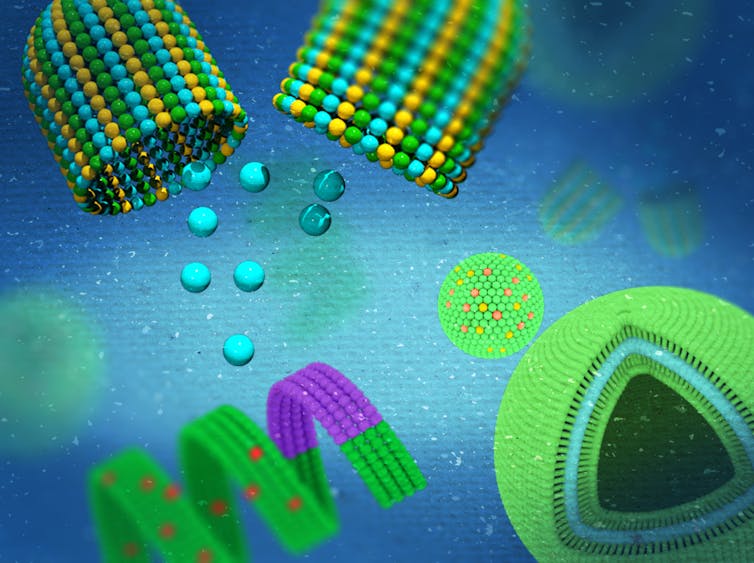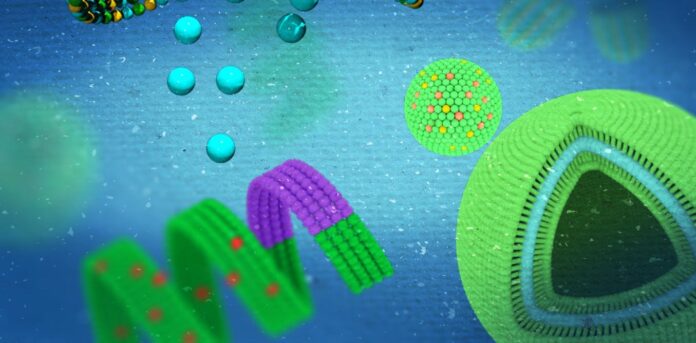Nanoparticles will change the world, but whether it’s for the better depends on decisions made now

By Kristin Omberg, Pacific Northwest National Laboratory
Technologies based on nanoscale materials – for example, particles that are more than 10,000 times smaller than the period at the end of this sentence – play a growing role in our world.
Carbon nanofibers strengthen airplanes and bicycle frames, silver nanoparticles make bacteria-resistant fabrics, and moisturizing nanoparticles called nanoliposomes are used in cosmetics.
Nanotechnology is also revolutionizing medicine and pushing the boundaries of human performance. If you received a COVID-19 vaccine in the United States, it contained nanoparticles.
In the future, nanotechnology may allow doctors to better treat brain diseases and disorders like cancer and dementia because nanoparticles pass easily through the blood-brain barrier.
Nanoparticles in eye drops may temporarily correct vision. And strategically implanted nanoparticles in the eyes, ears or brain may enable night vision or hearing that’s as good as a dog’s. Nanoparticles could even allow people to control their smart homes and cars with their brains.
This isn’t science fiction. These are all active areas of research.
But frameworks for assessing the safety and ethics of nanoparticles have not kept pace with research. As a chemist working in bioscience, this limited oversight worries me. Without updated frameworks, it’s hard to tell whether nanotechnology will make the world a better place.
Nano – what and why?
Any particle or material between 1 and 100 nanometers in one dimension can be classified as “nano.” The period at the end of this sentence is 1,000,000 nanometers, and a human hair is about 100,000 nm in diameter. Both are much too large to be considered “nano.” A single coronavirus is about 100 nanometers in diameter, and soot particles from forest fires can be as small as 10 nanometers in diameter – two examples of naturally occurring nanoparticles.
Nanoparticles can also be produced in a laboratory. The adenovirus vectors, nanolipoparticles and mRNA used in COVID-19 vaccines are engineered nanoparticles. The zinc oxide and titanium dioxide used in sheer mineral sunscreens are also engineered nanoparticles, as is the carbon nanofiber in airplanes and bicycle frames.
Nanoparticles are useful because they have different properties than larger materials, even when they have the same chemical composition. For example, large particles of zinc oxide can’t be dissolved in water and are used as pigment in white paint.
Nanoscale zinc oxide is used in sunscreen, where it looks nearly transparent but reflects sunlight away from your skin to prevent sunburn.
Nanoscale zinc oxide also exhibits antifungal and antibacterial properties that could be useful for making antimicrobial surfaces, but the reason for its antimicrobial properties is not completely understood.
And therein lies the problem. While many scientists are interested in exploiting the positive properties of nanomaterials, my colleagues and I are concerned that scientists still don’t know enough about their behavior.
Nanotechnology safety
Nanoparticles are attractive to biomedical researchers because they can slip through cell membranes. The antimicrobial properties of nanoscale zinc oxide are probably related to their ability to cross bacterial cell membranes. But these nanoparticles can cross human cell membranes as well.
In the United States, zinc oxide is “generally recognized as safe and effective” by the Food and Drug Administration for products like sunscreen because it’s unlikely – in sunscreen – to be toxic to humans.
However, although scientists understand the health effects of large particles of zinc oxide fairly well, they don’t fully understand the health effects of nanoscale zinc oxide. Laboratory studies using human cells have produced conflicting results, ranging from inflammation to cell death.
I’m a big believer in sunscreen. But I also worry about the environmental effects of particles that are known to cross cell membranes.
Hundreds of tons of nano-zinc oxide are produced each year, and it doesn’t degrade easily. If we don’t understand its behavior better, there’s no way to predict whether it will eventually become a problem – though increasing evidence suggests nano-zinc oxide from sunscreen is damaging coral reefs.
Nanotechnology ethics
Nanoparticles’ ability to cross cell membranes does make them effective in therapeutics like vaccines. Nanoparticles show promise for regenerating skeletal muscles, and they could one day treat muscular dystrophy, or the natural atrophy that comes with age.
But COVID-19 vaccines provide a cautionary tale – nanoparticle-enabled COVID-19 vaccines were quickly adopted by the United States and Europe, but lower income countries had far less access due to patent protections on the vaccine and a lack of production and storage infrastructure.
Nanoparticles may also allow for human performance enhancements, ranging from better eyesight to soldiers engineered to be more effective in combat.
Without an ethical framework for their use, performance-enhancing nanotechnologies that are accessible only in certain places could deepen wealth gaps between high- and low-income countries.
Emerging oversight
Today, different countries treat nanoparticles differently. For example, the European Union’s Scientific Committee on Consumer Safety has banned the use of nanoscale zinc oxide in aerosol sunscreens across the E.U., citing their potential to get into lung cells and, from there, move to other parts of the body. The United States has not taken similar action.
The European Union has established a nanobiotechnology laboratory to study the health and environmental effects of nanoparticles.
In the United States, the National Nanotechnology Initiative, a coordinated government-sponsored research and development effort, is working to bring legal and ethical experts together with scientists. They’ll weigh the benefits and risks of nanotechnologies and disseminate information to other scientists and the public.
Overcoming the disparity in nanoparticle-enabled vaccine distribution is another issue altogether. The World Health Organization’s COVAX program sought to ensure fair and equitable access to COVID-related therapeutics. Similar measures should be considered for all nanotechnology-enabled medicine so everyone can benefit.
Synthetic biology is a field that is experiencing similarly rapid growth. For the past 20 years, the nonprofit iGEM Foundation has held an annual worldwide student competition, which it uses as a platform to teach young scientists to think about the broader implications of their work.
The iGEM Foundation requires participants to consider safety, security and whether their project is “good for the world.” The nanotechnology research community would benefit greatly from adopting a similar model. Nanotechnologies that change the world for the better require coordinating science and ethics to shape how they are used and controlled long after we create them.![]()
Kristin Omberg, Group Leader, Chemical and Biological Signatures, Pacific Northwest National Laboratory
This article is republished from The Conversation under a Creative Commons license. Read the original article.



